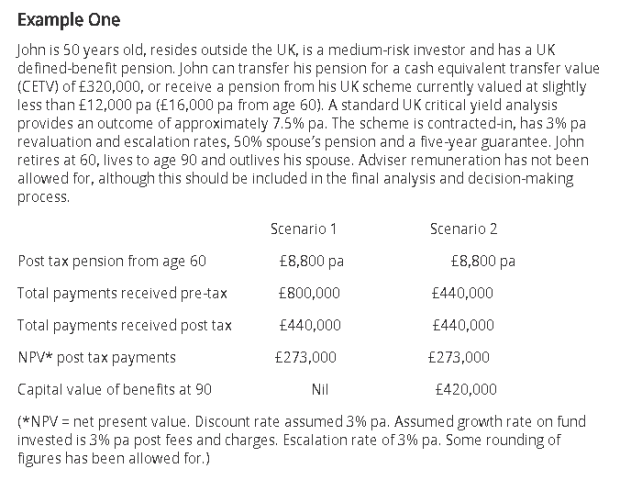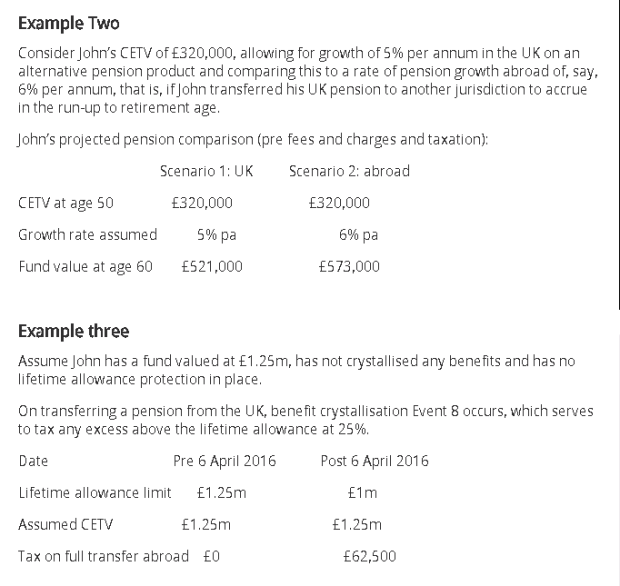Expert guide to UK pension transfers overseas
Darion Pohl, chief executive of Prism Xpat provides an expert view on the factors an adviser needs to take into account when considering a defined-benefit pension transfer to a recognised overseas pension scheme for a UK retiree planning to retire overseas.
This follows the introduction of the UK pension reforms in April 2015, via the Pensions Schemes Act 2015. When this analysis is undertaken in the UK, a main determinant of whether or not a final salary pension transfer will be in the client’s best interests is a critical yield analysis.
The aim is to work out the annual rate of return required for a transfer to an alternative UK pension scheme to make the defined-pension transfer at least as beneficial for the client over time. The outcome is considered with the client’s risk profile and overall personal circumstances to determine the most appropriate advice.
But what if the client is resident abroad and not planning on returning to the UK? How relevant is the standard critical yield analysis? What other factors need to be considered?
Double tax agreements
When considering the financial effect of a pension transfer abroad, there are many more things to consider for non-UK tax residents than there are for UK nationals. These include the effect of double tax agreements (DTAs), growth rate assumptions set by overseas regulators (pre-post tax), nil-rate tax band levels, tax exemptions associated with different visa classes, and international morbidity and mortality rates.
The effect of DTAs between the UK and other countries is fundamental. DTAs outline how UK pensions are taxed for those who have moved overseas. In many cases, the DTA indicates that tax payable is determined by the jurisdiction in which the client is tax resident and no longer taxed in the UK. In other cases, the onus falls back onto the UK to tax the benefits.
This difference can significantly affect whether a pension transfer is in the client’s best financial interests. In many cases, this factor can be more important on arriving at a transfer decision than relying on the outcome of the UK’s critical yield analysis, which is based on a UK-UK transfer.
Put simply, a critical yield (net of tax) needs to be calculated allowing for the effect of the DTA. Consider an example case in which a DTA exists with the UK and the pension is taxed in the country of residence (see Example 1).
Key assumptions
In this case study (Example 1), there are three further particular assumptions. First, that John’s country of residence taxes worldwide income, including receipt of his UK pension payments, at his local marginal tax rate. Second, for any pension transfer into John’s country of residence, no tax is payable on transfer of funds, growth of the fund after retirement or pension drawings. Third, there are no limits on contribution levels and no UK lifetime allowance taxation issues applicable.
Although John’s critical yield (after fees) is likely to be higher in some cases than that considered reasonable for a UK-UK pension transfer, especially after allowing for adviser and fund-based remuneration, could it still make sense for John to transfer his pension to a recognised overseas pension schemes (ROPS) abroad (all other factors being equal)?
Home Tax & Technical Expert guide…
Expert guide to UK pension transfers overseas
By Darion Pohl
Added 19th November 2015
Darion Pohl, chief executive of Prism Xpat provides an expert view on the factors an adviser needs to take into account when considering a defined-benefit pension transfer to a recognised overseas pension scheme for a UK retiree planning to retire overseas.
In scenario one, John draws his pension from the UK scheme as income and is taxed at his marginal tax rate abroad, assuming a 45% marginal rate on income. In scenario two, John transfers his UK pension entitlement to a locally based ROPS and draws his pension from the ROPS at the same level that he would have received from the UK scheme after tax.
Putting the two scenarios together, even though the UK critical yield is regarded as being relatively high, after also allowing for fees, the tax differential has resulted in a significant extra fund value available for John to pass onto his beneficiaries on death. There is no real comparative after-tax loss of income compared with receiving the pension from John’s UK scheme over time. This extra benefit could also have been re-allocated over time to help John further supplement his income during his retirement.
There are other things that will have a significant bearing on whether a defined-benefit pension transfer to a ROPS is in the client’s best interests. Namely, the effect of growth rates, inflation rates, taxation within the fund, country risks, exchange rates and mortality rates. These considerations will also help to establish whether the comparative UK critical yield is an appropriate measure for decision-making, and if not, what critical yield level should be deemed appropriate?
As one example, pension regulators in different countries set different growth rate assumptions for the purposes of forecasting pension benefits. The Financial Conduct Authority has a standard growth rate assumption of 2%/5%/8% for projecting pension benefits on a gross basis for low-growth/medium-growth/high-growth portfolios. Many UK pension providers tend to also project based on real rates of return at -0.6%/2.4%/5.4% per annum.
If the jurisdiction abroad has a different set of assumptions for growth and inflation pre/post retirement age – which tends to invariably be the case – things will be different (see Example 2). The 1% per annum difference between these two scenarios makes a big change to the value of John’s fund at retirement age, and would lower the comparative critical yield required from an overseas scheme compared with considering a UK-to-UK transfer in isolation.
Lifetime allowance
The effect of the reduced lifetime allowance in the UK, lowering from £1.25m to £1m from April 2016, is another key factor. The lifetime allowance is an overall aggregated allowance of the amount of UK pensions a client is entitled to hold at concessional UK tax rates during their lifetime (see Example 3). In Example 3, unless John was locked into fixed protection, on transfer after 6 April 2016, the reduction in the lifetime allowance could create an extra tax liability on transfer of £62,500. This needs to be properly factored into the current UK tax year’s advice.
When considering the taxation of death benefits from pension schemes, it is essential that jurisdictional differences are properly allowed for. This encompasses not only the payment of any capital or residual benefits, but also the situation with regards to protection of the client’s estate from any carry over of UK inheritance tax, or the imposition of local death taxes and duties.
Complex issues
This article accentuates the complexity and some of the many international factors that need to be considered when deciding whether a UK defined-benefit pension transfer to a ROPS is in a non-UK resident client’s best interests. A projection of benefits cannot be limited to a UK critical yield analysis and associated illustrations.
This decision needs to be properly balanced with the client’s ability to take on the management of investment and longevity risk as well as their own personal circumstances and financial goals.
It is important the appointed adviser has international experience and holds the relevant qualifications to properly handle the considerations when dealing with non-UK resident clients.





